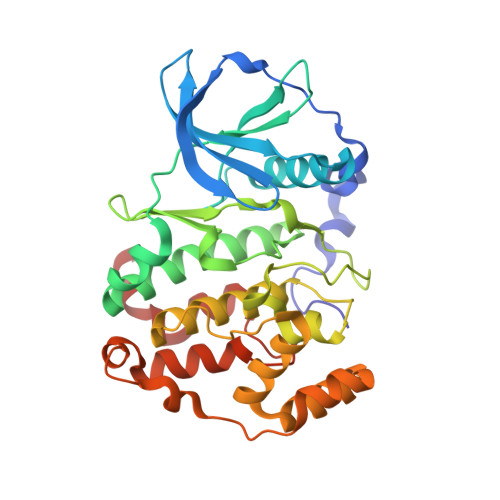ATP site-directed inhibitors of protein kinase CK2: an update.
Sarno, S., Papinutto, E., Franchin, C., Bain, J., Elliott, M., Meggio, F., Kazimierczuk, Z., Orzeszko, A., Zanotti, G., Battistutta, R., Pinna, L.A.(2011) Curr Top Med Chem 11: 1340-1351
- PubMed: 21513497
- DOI: https://doi.org/10.2174/156802611795589638
- Primary Citation of Related Structures:
3KXG, 3KXH, 3KXM, 3KXN, 3PVG - PubMed Abstract:
CK2 denotes a pleiotropic, constitutively active protein kinase whose abnormally high level in many cancer cells is held as an example of "non oncogene addiction". A wide spectrum of cell permeable, fairly specific ATP site-directed CK2 inhibitors are currently available which are proving useful to dissect its biological functions and which share the property of inducing apoptosis of cancer cells with no comparable effect on their "normal" counterparts. One of these, CX-4945, has recently entered clinical trials for the treatment of advanced solid tumors, Castelman's disease and multiple myeloma. The solution of a wide range of 3D structures of inhibitors bound to the catalytic subunits of CK2 reveals that their efficacy substantially relies on hydrophobic interactions within a cavity which is smaller than in other protein kinases. Accordingly the potency of tetra-halogenated benzimidazoles increases upon replacement of chlorine by bromine and, even more, by iodine, and decreases if two unique bulky side chains on CK2 (Val66 and Ile174) are mutated to alanines. Many CK2 inhibitors have been tested on a panel of more than 60 kinases providing Promiscuity Scores useful to evaluate their selectivity, the lowest value (9.47), denoting highest selectivity, being displayed by quinalizarin. The observation that CK2 inhibitors with medium/high promiscuity scores share the ability to inhibit a group of protein kinases as effectively as CK2 discloses the possibility of using their scaffolds for the rational development of selective inhibitors of these kinases, with special reference to PIMs, DYRKs, HIPK2, PKD and ERK8.
Organizational Affiliation:
Department of Biological Chemistry and CNR Institute of Neurosciences, University of Padova, Italy.















